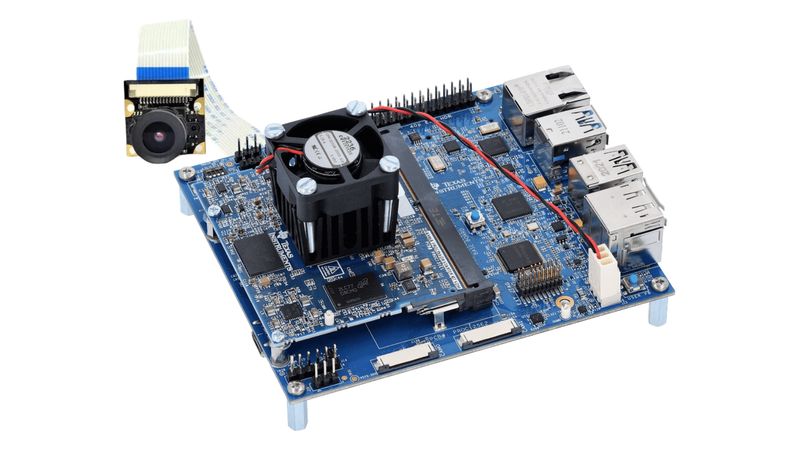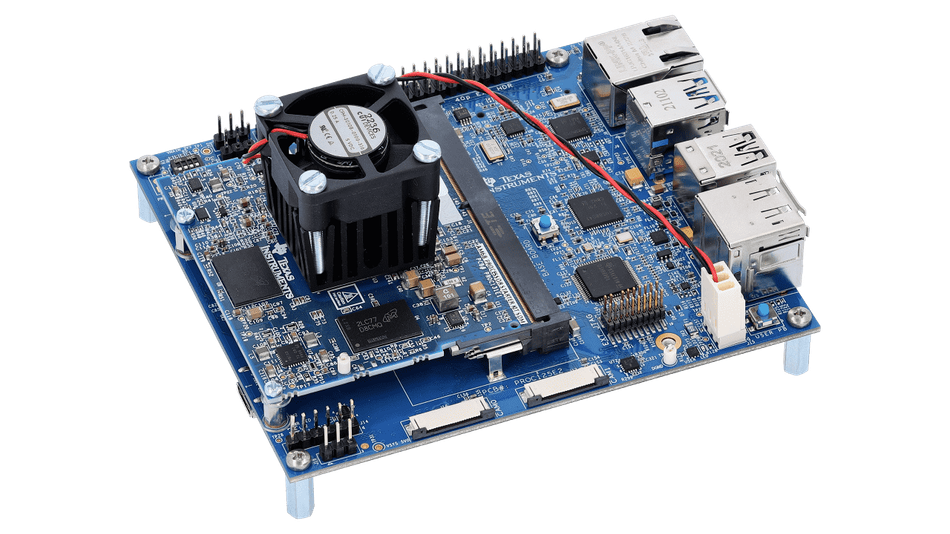Building Robust Edge AI Computer Vision Applications with High-Performance Microprocessors
High-performance microprocessors with AI hardware acceleration are revolutionizing Edge AI, enabling advanced computer vision capabilities directly on devices for real-time data processing and analysis.
Introduction
Artificial intelligence (AI) is experiencing a significant transition with the increasing adoption of edge computing, where data processing occurs closer to the data source. The aim is to enable real-time decision-making and reduce dependency on cloud services.
This transition is driven by advanced microprocessors, with the Texas Instruments AM68A being a notable example. It offers a combination of efficiency, power, and adaptability, making it well-suited for the requirements of Edge AI applications.
In this article, we uncover the capabilities and implications of the Texas Instruments AM68A within the Edge AI landscape. Our exploration will dive into the intricacies of its technological features and spotlight its integration with the Edge Impulse platform. We'll also feature some case studies that demonstrate the practical application of the AM68A in Edge AI projects focused on computer vision.
Overview of the Texas Instruments AM68A
The Texas Instruments AM68A is a microprocessor that delivers great performance and features dedicated AI hardware acceleration. This enhancement is crucial for optimizing AI tasks directly on the device, enhancing efficiency and processing speed.
Before exploring its diverse uses and influence in Edge AI, it's essential to understand its core specifications and features. This groundwork will provide a clear perspective on the microprocessor's capabilities and how it can be utilized in various Edge AI contexts.
Here are some core specifications and features of the AM68A:
Feature | Description |
Processor Core | Dual 64-bit ARM Cortex-A72 microprocessor subsystems, up to 2 GHz, with a shared 1MB L2 cache. |
Deep Learning Accelerators | Deep Learning Accelerator capable of up to 8 TOPS, for efficient AI computations and real-time data processing. |
Vision Processing | Vision Processing Accelerators, including an Image Signal Processor and multiple vision assist accelerators for handling image and video data. |
Additional Processing Units | Dual-core ARM Cortex-R5F MCUs for general compute operations and device management. |
Graphics Processing | IMG BXS-4-64, a high-performance 3D GPU supporting OpenGL ES 3.1 and Vulkan 1.2 for graphic-intensive applications. |
Connectivity Options | Gigabit ethernet, USB 3.0, CSI 2.0, PCIe gen 3, and various memory interfaces. |
Security Features | Secure boot and crypto hardware accelerators for robust security. |
Table 1: Specifications and features of Texas Instruments AM68A
The Role of Deep Learning Accelerators in Edge AI
The Texas Instruments AM68A has deep learning accelerators, which play a crucial role in Edge AI and computer vision applications. These are specialized hardware components designed to efficiently execute the computations required for deep learning algorithms. Unlike general-purpose processors, these accelerators are optimized for specific tasks like matrix multiplications and convolutions, which are fundamental in neural network operations.
The significance of deep learning accelerators in edge computing lies in their ability to bring advanced AI functionalities to devices operating at the edge of networks. By handling complex computations locally, these accelerators reduce the need to transmit large amounts of data to the cloud for processing. This cuts down on latency, making real-time processing feasible, and addresses concerns like bandwidth limitations and data privacy.
Real-World Applications and Case Studies
The Texas Instruments AM68A has been central to a variety of computer vision projects, demonstrating its versatility and capability. These case studies showcase the practical use of the AM68A in diverse Edge AI applications.
1. American Sign Language (ASL) Translation
One of the remarkable projects developed using a Texas Instruments board is an American Sign Language (ASL) Translation system. This application utilizes the AM62A, the entry-level alternative to the AM68A, and is designed to translate ASL into text in real-time. By leveraging machine learning algorithms and image processing capabilities, this system enhances communication accessibility for the deaf and hard-of-hearing community.
The project's success on the AM62A highlights the potential advancements that could be achieved with the more powerful AM68A.
Read more about this project: Import a Pretrained Model with "Bring Your Own Model" - Texas Instruments AM62A
2. Motorcycle Helmet Detection
Another innovative application is the Motorcycle Helmet Detection project. Also developed on the Texas Instruments AM62A, this system utilizes machine learning and computer vision to detect whether motorcyclists are wearing helmets. This application is crucial for enhancing road safety and can be deployed at traffic signals or highway checkpoints.
The implementation with the AM62A demonstrates the feasibility of such safety applications, which can be further optimized with the AM68A's enhanced capabilities.
Explore this project in detail: Motorcycle Helmet Identification and Traffic Light Control - Texas Instruments AM62A
3. Posture Detection
The Texas Instruments TDA4VM board, another counterpart of the AM68A with fewer features, has been used in a posture detection project. This application focuses on identifying incorrect postures in real-time to prevent workplace injuries. Using advanced image processing and AI, the system provides immediate feedback for posture correction.
The AM68A, with its superior processing power, could elevate such health and safety applications to new levels.
Learn more about this project: Correct Posture Detection and Enforcement - Texas Instruments TDA4VM
4. Smart Factory Prototype
Finally, the Smart Factory Prototype project, developed on the Texas Instruments TDA4VM, illustrates the potential of these boards in industrial applications. This system employs AI to monitor manufacturing processes, enhancing efficiency and predicting maintenance needs. The project demonstrates how edge computing can revolutionize industrial operations, and with the advanced features of the AM68A, these applications could achieve even greater efficiency and accuracy.
Read more about the Smart Factory Prototype: Smart Factory Prototype - Texas Instruments TDA4VM
Transitioning to the AM68A
Each of these projects, developed on the AM62A and TDA4VM boards, lays the groundwork for what could be achieved with the AM68A. With its enhanced processing power and deep learning capabilities, the AM68A is poised to elevate these applications, offering more efficient processing, quicker response times, and the ability to handle more complex AI models. This transition represents a significant step forward in the capabilities of edge computing devices and their applications across various industries.
Conclusion
The AM68A, with its advanced deep learning accelerators and enhanced processing capabilities, stands as a significant player in the rapidly evolving landscape of edge computing. Its integration with the Edge Impulse platform has opened new avenues for AI model development, making advanced AI functionalities more accessible and effective.
Throughout the article, we've seen how the AM68A is being utilized in various sectors, from enhancing road safety with motorcycle helmet detection to improving workplace ergonomics through posture detection. These applications, initially developed on the AM62A and TDA4VM, offer a glimpse into the possibilities with the more advanced AM68A. The chip's potential in driving innovations in smart factories, healthcare monitoring, environmental analysis, and beyond, underscores its versatility and efficiency in handling diverse Edge AI applications.
About the sponsor: Edge Impulse
Edge Impulse is the leading development platform for embedded machine learning, used by over 1,000 enterprises across 200,000 ML projects worldwide. We are on a mission to enable the ultimate development experience for machine learning on embedded devices for sensors, audio, and computer vision, at scale.
From getting started in under five minutes to MLOps in production, we enable highly optimized ML deployable to a wide range of hardware from MCUs to CPUs, to custom AI accelerators. With Edge Impulse, developers, engineers, and domain experts solve real problems using machine learning in embedded solutions, speeding up development time from years to weeks. We specialize in industrial and professional applications including predictive maintenance, anomaly detection, human health, wearables, and more.






